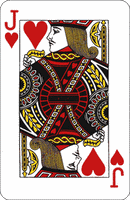Playing Card Size, How Big is a Playing Card?
The simple answer is that the dimensions of the common playing card is approximately B8 size, 62mm wide by 88mm length (2.45 inches by 3.5 inches). The not so simple answer is that for Bridge, playing cards are 2.25 inches by 3.5 inches, and for Poker, playing cards are 2.5 inches by 3.5 inches. Therefore, B8 is a good common ground.

Some Detail on Playing Card Size
You probably came to this page via an Internet search. Which produces the above quick answer to the answering the question on the size of a playing card. But the quick answer is not the simple answer, because of the two sizes. Hence on some playing card boxes it will say Poker Size or Bridge Size. To get to the above quick answer answer you need to look at some detail.
There are hundreds, possibly several hundred, of different playing card games, and the type of game can influence the design and size of the playing card. The popularity of games varies from country to country, with some games played exclusively in a particular country, and the cards used in those countries may not look familiar to people from outside that country. However, some games are popular in many countries, games like Bridge, and Rummy, and casino games such as Blackjack and Baccarat; plus the game of Poker has seen a huge growth in popularity, fuelled by online gaming. These games mean that the Anglo-American style of playing cards, derived from early French designs, is almost universally available and recognisable. The Jack of Hearts aboove is an example of the common card style. The common pack of playing cards can be purchased in almost any town and city.
The common deck consists of 54 playing cards, divided into four Suits of thirteen cards, and two Jokers. The Suits are Spades, Hearts, Diamonds and Clubs. The thirteen cards are Ace, 2 to 10, Jack, Queen and King. This type of deck is widely available in Poker size, 2.5 inches by 3.5 inches. However the deck can also be brought in Bridge size 2.25 inches by 3.5 inches, because in the game of Bridge you need to hold a lot of cards and using a narrower card helps. Measurements are in Imperial inches because mass card manufacture became dominated by British and American printers prior to the widespread use of metric measurements.
There is no standard for playing card size, it is entirely down to tradition and manufacturers whims. Although cards too big would be uncomfortable to hold and shuffle, and cards too small difficult to read and shuffle. I measured seven packs of cards in my possession, all from different manufacturers:
Table of Sampled Playing Card Sizes
All Sizes are in Inches
| Width | Length | |
|---|---|---|
| Pack 1 | 2.5 | 3.5 |
| Pack 2 | 2.25 | 3 and 7/16 (3.4375) |
| Pack 3 | 2.5 | 3 and 7/16 (3.4375) |
| Pack 4 | 2.25 | 3 and 7/16 (3.4375) |
| Pack 5 | 2.25 | 3.5 |
| Pack 6 | 2.5 | 3 and 7/16 (3.4375) |
| Pack 7 | 2.5 | 3.5 |
The widths of 2.25 and 2.5 inches convert to 57 and 63.5 millimetres, the heights 3 and 7/16th and 3.5 inches convert to 87 and 89 milimetres. Looking up international standards for paper sizes (ISO 216) a good fit for a playing card is paper size B8, 62mm by 88mm. Now we can provide a simple answer to those that require it.
The Simple Answer
So, how big is a playing card? The dimensions of the common playing card is approximately B8 size, 62mm wide by 88mm length (2.45 inches by 3.5 inches).
The Not So Simple Answer
For Bridge, playing cards are 2.25 inches by 3.5 inches. For Poker, playing cards are 2.5 inches by 3.5 inches.
See Also
- For a large table of playing card sizes see http://www.numericana.com/answer/cards.htm
- Those interested in cards to use in software can view and download these Scalar Vector Graphics (SVG) versions of playing cards.
- For a full list of all the articles in Tek Eye see the full site Index.
Author:Daniel S. Fowler Published: Updated:







